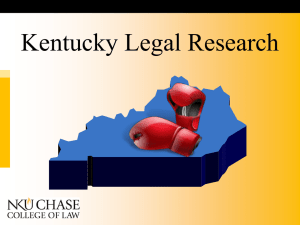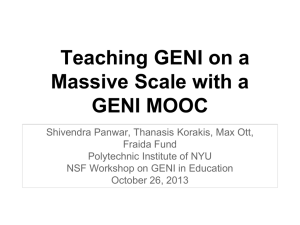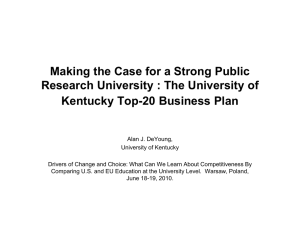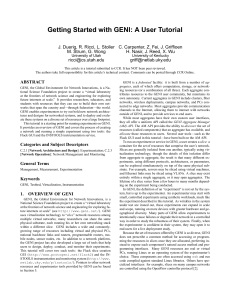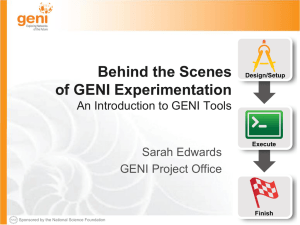10-Fei-NSFworkshop_fei
advertisement
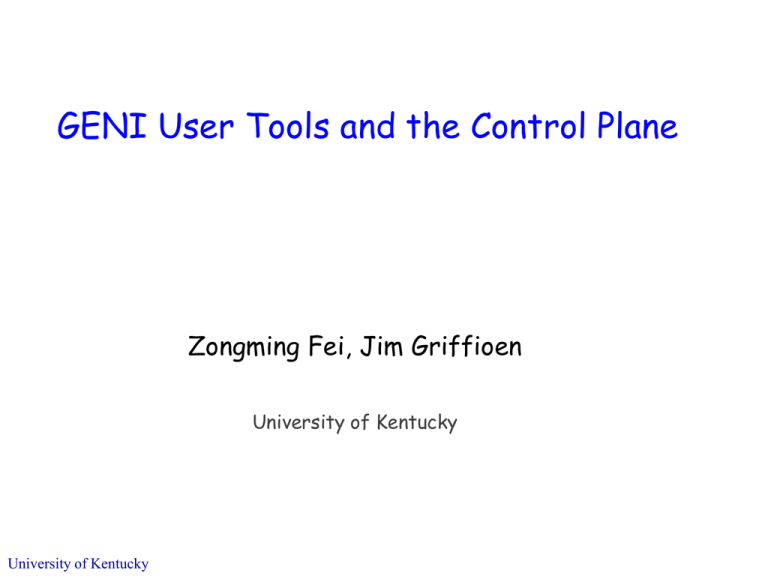
GENI User Tools and the Control Plane Zongming Fei, Jim Griffioen University of Kentucky University of Kentucky GENI Desktop Motivations GENI has developed multiple control frameworks, ProtoGENI/InstaGENI, ORCA/ExoGENI, ORBIT, etc. Different interfaces to access resources, Flack, Fluke, OMNI, AM API, etc. A variety of instrumentation and measurement systems, INSTOOLS, PerfSONAR/AM, OML, OnTime measure Run time control, GUSH, Raven various archive services The goal of the GENI Desktop is to provide a unified graphical user interface (GUI) by which experimenters can create, control, interact with, and evaluate the performance of their experiments. University of Kentucky GENI Desktop Features Single sign-on to various GENI tools ssh access to a set of nodes. Interoperates with the GENI Portal, Flack, and iRods Ability to run commands across sets of nodes. Supports InstaGENI and ExoGENI racks and cross-aggregate stitching Ability to upload files to sets of nodes. Access to all slices owned by user Optional instrumentation of a slice Slice creation/modification via Flack, the Portal, or RSPECs Quick access to, and visualization of, commonly used measurement data. A windowing system interface Logical, Geographic, and List view of slice Ability to drill down to additional measurement information Single abstraction for interacting with a slice. Ability to control active and passive measurements Can be used with/without instrumentation (active or passive) Ability to record notes about an experiment via a CMS and several other features. Quick access to (instantiated) resource details. University of Kentucky Overview of Slices University of Kentucky A list of actions on slices University of Kentucky Working on a slice University of Kentucky I&M Traffic View University of Kentucky The GENI Desktop Unifying Abstraction Goal: Support multiple ways to “visualize” a slice, and Make it easy to apply an operation to a subset of resources within a slice. Common Requirement: Select Resources: Provide a unified well-known way to select resources, regardless of the “view” of the slice. Apply Operations: Provide a unified well-known way to apply an operation to a set of resources. Idea: Use an abstraction familiar to users Solution: Model the interface after the well-known file browser interface. The analogy is selecting files in a file browser and applying an operation (regardless of the “view” – e.g., list view, icon view, detailed view, etc.) University of Kentucky Slice/Topology “Views” Three types of Views Logical View Provides a logical view of the topology and links between nodes. Nodes and links can be selected to identify a set of nodes/links. Geographic/Map View Provides a map view of the topology showing the geographic location where nodes are located and the links connecting them. Nodes and links can be selected to identify a set of nodes/links. List View A textual list of the nodes and links in a slice. Nodes and links can be selected to identify a set of nodes/links. The list can be filtered (searched) to reduce the number of nodes/links displayed. Observations There is a single unified interaction model Selecting nodes/links in one view selects the same nodes/links in another view. Logical and Geographic views make it easy to visualize the topology and interconnections between nodes. The List view is useful for large topologies because the topology can be quickly filtered to nodes/links of interest. University of Kentucky User tool as a part of Cyberinfrastructure Provide a common abstraction for users to interact with the cyberinfrastructure Hide the differences between different control frameworks Unify the interaction models Provide instrumentation and measurement Monitor and performance measurement usually is not the main focus of control frameworks, but it is an important aspect of experimentation Provide a GUI that is easy to use for beginners (students, and scientists of non-CS discipline), but script interface for advanced users University of Kentucky User tool and control plane A tool may act as a representative of a user to make requests to the control plane Authentication/authorization/accountability, Speaks-for A tool may need to query about the status and other information about user experiments Standard API across interoperable frameworks A tool may have to change the components of a user experiment (RSpec) consistent across different frameworks University of Kentucky Thank You! This material is based upon work supported in part by the National Science Foundation under grant number CNS-0834243. Any opinions, findings, and conclusions or recommendations expressed in this material are those of the authors and do not necessarily reflect the views of GPO Technologies, Corp, the GENI Project Office, or the National Science Foundation. University of Kentucky

